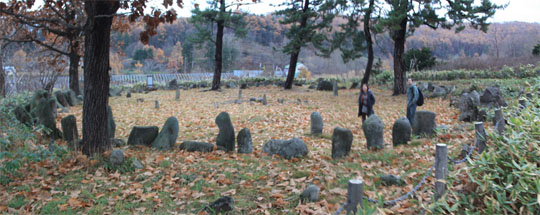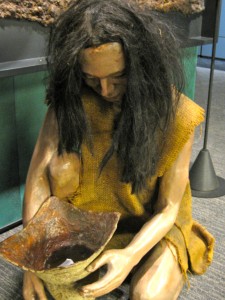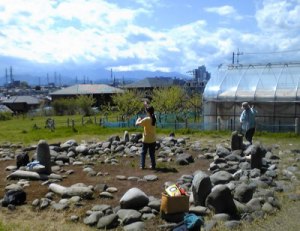
The Oshoro stone cirlce in south-west Hokkaido (courtesy Japan Times)
It’s sometimes said that Shinto’s roots lie in the Yayoi period (300BC – 250 AD), when incomers from the continent brought in beliefs connected with wet-rice agriculture from Korea and China. So what was the situation before that?
It seems no one knows for sure about spirituality in the Jomon age (c.14,000BC – 300BC), though archaeologists have put forward theories connected to unearthed items, such as the mysterious dogu featured in a previous posting. Along with the artifacts are stone circles, normally associated with Britain and northern Europe.
In the article below, the suggestion is that the stone circle here, like Stonehenge, was essentially a place for the dead. And in the final sentence comes a statement about Jomon people believing that objects had souls. It seems then that even in Jomon times there was a bedrock of animism and ancestor worship such as underlies modern Japanese spirituality – though the form it took was undoubtedly of a very different kind from the beliefs that supplanted it in Yayoi times.
********************************************************************
Mystery shrouds the ancient Oshoro circle
BY MICHAEL HOFFMAN in The Japan Times
The Late Jomon period (circa 2400-1000 B.C.) was an age of northward migration. The north was warming, and severe rainfall was ravaging the established Jomon sites, primarily in the vicinity of today’s Tokyo and Nagoya.
Perhaps resettlement stimulated thought, for it coincided with a novel Jomon institution — the cemetery.
“By devoting a special area to burials,” writes J. Edward Kidder in “The Cambridge History of Japan,” “Late Jomon people were isolating the dead, allowing the gap to be bridged by mediums who eventually drew the rational world of the living further away from the spirit world of the dead.”
 The Oshoro Stone Circle was probably a cemetery.
The Oshoro Stone Circle was probably a cemetery.
It was other things as well, but primarily that, says Naoaki Ishikawa, chief curator of the Otaru Museum, where many of the finds from around this stone circle can be viewed.
It is one of about 30 Late Jomon stone circles scattered through northern Japan. In terms of size it ranks about midway between the smallest enclosures and the largest one at Oyu, Akita Prefecture, bounded by thousands of stones.
No bones have been found to make an airtight case of the cemetery theory, but relatively few Jomon bones have been found anywhere, the acid in the soil claiming them long before the archaeologist’s trowel can.
Why regard it as a cemetery? Partly, says Ishikawa, because of the large number of unidentifiable, and probably ritual, objects unearthed in the vicinity; partly because of the many tools found unbroken, suggesting grave goods; partly also because “graves are among the few things that would have justified the degree of effort involved.
Constructing a stone circle is a major undertaking. You have to flatten the land, quarry the stones, transport them, lay them out. . . . Only something of the highest importance could have taken people away from their daily hunting and gathering.”

Tabata stone circle in Machida city. On the winter sostice, the sun sets exactly over the top of Mt Hirugatake.
Very likely also, he says, it was a market, a trading center for the exchange of tools, local foods, regional products, lacquer — and information, gossip. What would people have said to each other? In what language? Not Japanese, writes archaeologist Richard Pearson in the International Jomon Culture Conference Newsletter. Proto-Japanese, he says, only begins with the succeeding Yayoi culture.
Ishikawa raises another possibility for the Oshoro Stone Circle — that it could have been a trash dump, which would explain the roughly 400,000 tool and pottery fragments so far unearthed there. “Things may have been brought on purpose to such a site for ritual disposal,” he says.
“To the Jomon, each object, animate and inanimate, housed a spirit. Throwing things away would have been done ceremonially.”
********************************************************
For an excellent article on the Jomon stone circles, see the Heritage of Japan article here.
*********************************************************

actually we can say much on believes of Jomon people. as far as Jomon people were direct ancestors of Ainu, analyzing Ainu belief and with use of archaelogy and other data we can reconstruct Jomon faith in a pretty precesious way.